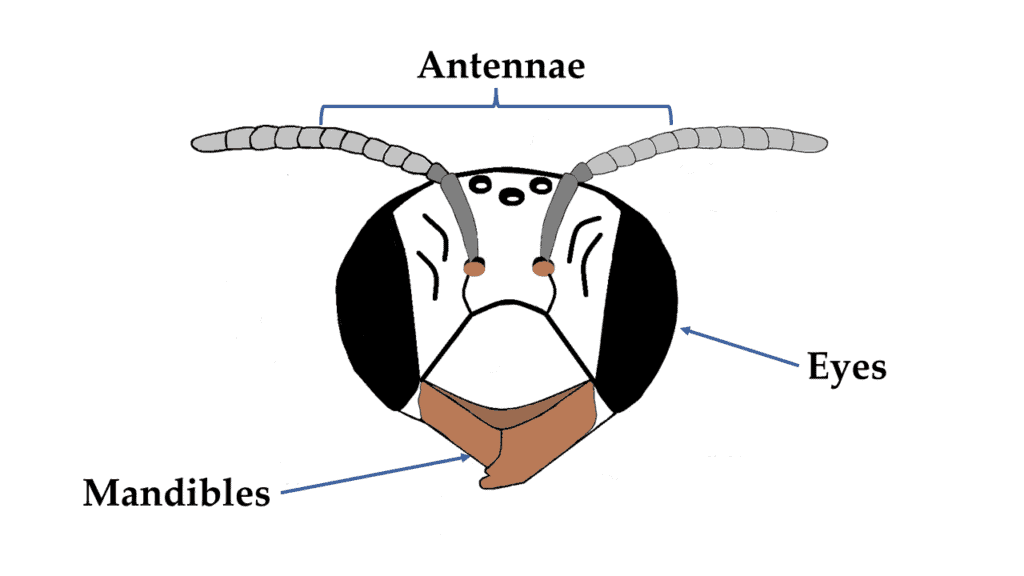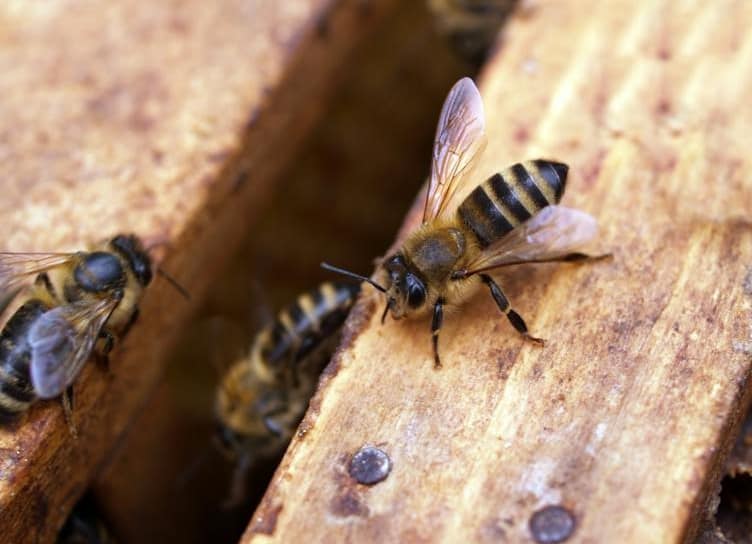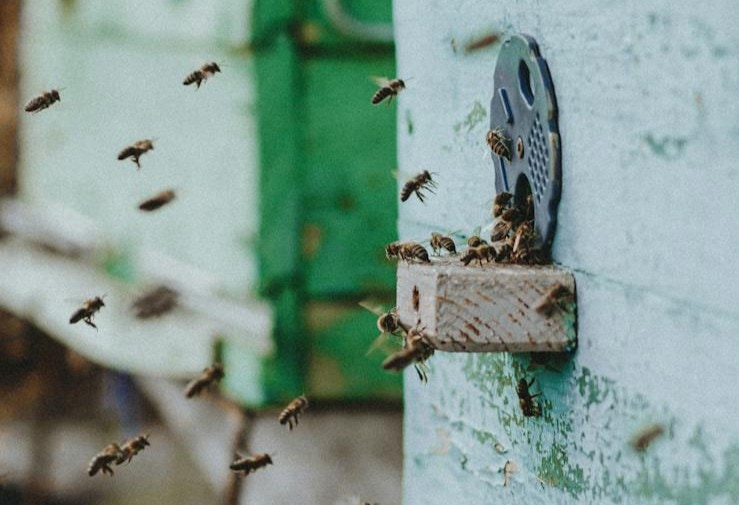Do bees have ears? Just another question about bees that may have crossed our minds.
A bee’s anatomy tells a fascinating story. But for this post, we turn our focus first on the bee’s head to find the answer to that question.
The Bee’s Head
The main external features of a bee’s head are the eyes, mandibles, and antennae. It does not include an ear. The image below shows these body parts in a bee’s head.

Now that we have a good look at a bee’s head, we can say that bees don’t have ears. But this does not mean that they are deaf and cannot hear. Despite the lack of auditory organs, bees can hear and respond well to sounds.
A study on the hearing capabilities of bees conducted by Towne and Kirchner in 1989 showed that bees hear by detecting the movement of air particles and airborne sounds.
How do Bees hear Without Ears?
So, what do the bees use to detect these sounds if they do not have ears?
Scientists and bee enthusiasts seem to be in consensus that bees detect vibroacoustic signals and sounds using their legs and antennae.
We have discussed the basics of a bee’s eyes and mandibles in previous posts. It’s time to learn the basics about a bee’s antennae and its function.
The Bee’s Antennae
The bee’s antennae are composed of several segments.
The first segment at the base of the bee’s head is the scape. Its main function is to firmly hold the antennae to the head of the bee.
Then, there is the second segment, called the pedicel. It is an elbow-like joint in the bee’s antennae.
The third set of segments is the flagellum. These are the segments after the pedicel to the end of the antennae.
The Johnston’s Organ
A bee has a Johnston’s organ located in the pedicel. This organ is a set of sensory cells that function in collecting sound vibrations. These sensory cells detect movement in the flagellum. The Johnston’s organ then receives the mechanical vibrations in the flagellum and conveys the sound information to the brain.
This is a classic example of the reception of an air-borne vibration. When bees flap their wings and buzz about, air movements are received by the antennae and interpreted by the brain.

The Curious Case of Honey Bees
The Honey Bee’s Legs
Honeybees have subgenual organs found in the tibia of a bee’s legs. A honeybee’s subgenual organs receive substrate vibrations.
The vibrations are then transmitted as nerve impulses to the bee’s central nervous system and the brain to convey the message.
This process is referred to as the reception of sound through substrate-borne vibration.
Sound waves travel through the medium they are on (for example, the wood they are perching on). The vibration through the wood is received by the subgenual organs of the legs.
The Waggle Dance
Honey bees communicate through dance moves known as the “Waggle Dance.” This happens when a scout bee finds a flower with an abundance of pollen and nectar for food. Of course, the more nectar they can gather, the more honey they can produce.
This honey bee moves its abdomen in a waggle and vibrates its wings. The dancing bee would communicate the flower’s location to hive mates and worker bees by waggle dancing. This dance would create airborne sound signals that would call on other members of the colony to come and gather their fill.
A dancing honey bee emits an air vibration that directs the other bees to the location of the target flower. The waggle dance also informs the other bees of the distance of the flower from the hive.
Their sense of sound detection seems to be sensitive enough to identify movements in air particles within a few millimeters of a sound-emitting dancer. These vibroacoustic signals reach the bee, which makes them respond to them just like hearing a sound.
And this is how bees detect the sound frequency and respond to them. Hence, despite the lack of ears, bees can hear with their legs and antennae.

While this is true with honeybees, we cannot say the same applies to bumblebees and other bee species.
Further studies are being conducted to determine the applicability of study results conducted on honey bees to bumblebees and other bees.
That’s one more difference between bumble bees and honey bees. So when you see honey bees waggle dancing, don’t bother joining in, as it might just disturb them.
The better their signal is on where to gather lots of nectars, the more honey they can produce. The more they produce, the more your harvest is. And more honey equals more money, too!
How Well can Bees hear?
Depending on their frequency or cycles per second, sound waves are measured in Hertz (Hz). When bees flap their wings and buzz around, they create airborne sounds.
Honey bees, when performing their waggle dance, also emit sound waves. This is how honey bees detect sound frequencies and communicate with each other.
These bees are observed to create vibrations with a frequency as low as below 10 Hz and as high as around 1000 Hz.
Experiments have also shown that honey bees can detect sound vibrations for up to 500 Hertz.

Final Thoughts
Bees do not have ears. But our industrious six-legged friends are definitely not deaf. Unlike human hearing, bees do not need ears to hear. They can hear by sensing vibrations and air particle movements around them.
Interestingly, bees have sensitive chordotonal organs in their antennae and legs (for honeybees). These organs are mechanoreceptors that act as stimuli receptors and convey them as neural impulses.
There is no rule in science that all animals should receive sound through their ears.
Sounds are mere vibrations that become acoustic waves as they travel through transmission mediums such as air. Once it has been received, these sound waves are transmitted into the brain, where it is interpreted.
This basic explanation of the process of sound reception applies to bees. Instead of receiving the sound wave through their ears, they use their antennae and legs (in the case of honey bees) in sound reception.
